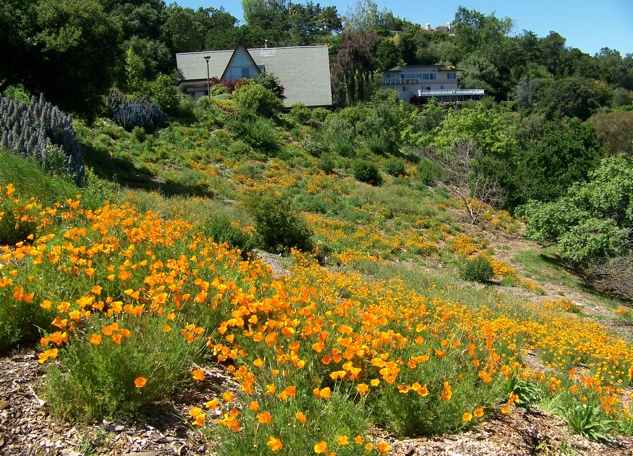

Los Altos Hills, two acres with poppies, were formerly a weed field until Ecological Restoration started, at the corner of Anacapa and Viscaino.
Los Altos Hills flowers blooming after a 100-year absence.
Copyright © 2017 by Craig Dremann.
The best wildflower planting in the Bay Area is in Los Altos Hills. Park at the corner of Anacapa and Viscaino when you drive up from Purissima, then walk down Viscaino past the first driveway of the left, and that is where the picture above was taken. .
My company, the Reveg Edge put together the plan to manage the two-acre hillside, normally choked each year by the fire-hazard European weed grasses, and convert it back to 100% local native and weed-free vegetation, by using Ecological Restoration.
Ecological Restoration
can produce the best sustainable landscaping solution--By changing the ecology back
to what existed, when everything was native.
Step-by-step Ecological Restoration strategies are:
(1.) Identify the natives that are already growing on the
property, because then you can conserve and protect them, so they
can convert more weed areas.
(2.) Mow weeds when green each spring, before the stems
turn brown--That way you eliminate a whole new generation of weed
seeds sprouting next year. Always mow gigh, 8-12 inches, never
lower or you could cut natives.
(3.) Rake off all of the cut weed straw, because that straw
contains natural herbicide-like chemicals that keep the native
seeds from sprouting or thriving. The weeds are like parasites
to the natives, stealing nutrients and space that the natives
need to survive. Use the straw to put on larger weeds like Italian
and Yellow star thistles.
(4.) Soil tests to see what the native plants need, and
add the proper organic fertilizers to feed their seedlings.
Once the land is properly managed, native wildflowers and
native grasses may sprout up on their own, without sowing a single
seed--California native seeds can lay dormant underneath the weeds,
sometimes 100-250 years.
Read where over 100 different wildflowers came up on their
own on 74 acres south of Santa Cruz at the Shaw property at
https://www.ecoseeds.com/shaw.pdf
The basic rule of thumb,
in April each year, if you only see green on the hills of California and no wildflowers
in that area, you are probably looking at a solid patch of European
weed grasses, and the local native plants need our help to survive
and recover.
So, convert the unirrigated parts of your property back to
solid wildflowers, and native grasses--Why keep mowing a weed
patch each summer, when just by adding Craig's Ecological Restoration
process, you could have wildflowers instead?
My process for homeowners starts, by go through the property
with the owners and/or landscape managers and take samples of
the native plants and the weed plants, and tape those examples
into file folders, so that the property owners can have examples
of what needs to be managed, and what plants need to be conserved.
The properties that I have worked on, located east or west
of I-280, always have a few natives hidden under the oaks, and
discovering what natives are left gives us an excellent clue on
what to convert the land to in the future.
That means each property in Hillsborough, Woodside, Portola
Valley, and Los Altos Hills have the potential to get back to
their original local wildflower beauty days.
NUMBER OF HOMES on
the Peninsula, in the place of weed-patches, could have native
grasslands and wildflower fields?
HILLSBOROUGH - Converting the unirrigated areas = 3,696 homes.
LOS ALTOS HILLS - Converting the unirrigated areas = 2,829 homes.
PORTOLA VALLEY - Converting the unirrigated areas = 1,746 homes.
WOODSIDE - Converting the unirrigated properties = 1,977 homes.
TOTAL unirrigated areas around homes, that could be future wildflower
fields = Over 10,000 !
"When you look out any window, you deserve to be looking
at a masterpiece landscape like something painted by Claude Monet,
because you paid for that view--Adding
the original native plants will give your place that charm and
beauty that had already existed for thousands of years. It is
like cleaning off a painting and finding an original Rembrandt
underneath."
-- Craig Dremann (2017)
Updated December 24, 2022 - The
Reveg Edge Ecological Restoration service